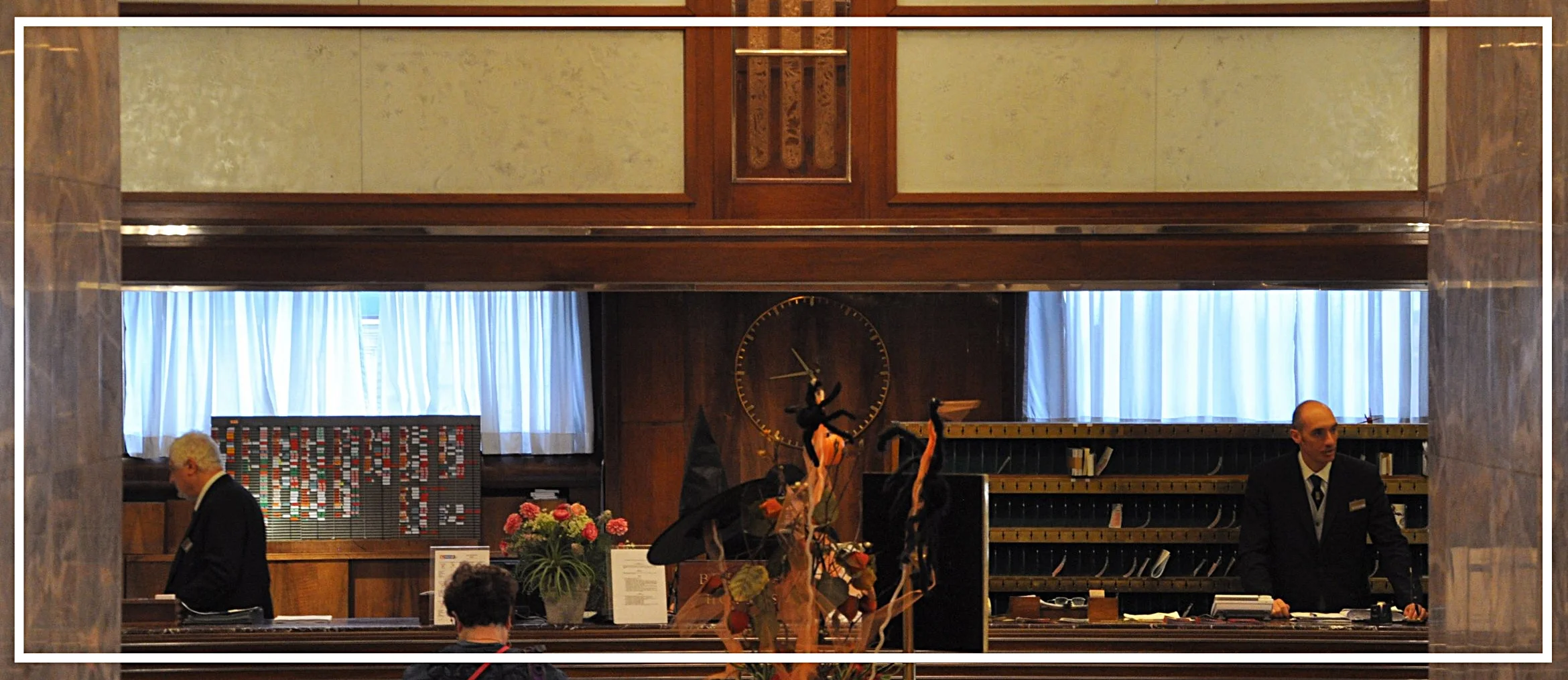Bettoja Hotel Mediterraneo | Rome, Italy
The word “hospitality” traces its roots from the latin hospitalitem - literally, “friendliness to guests.” And how appropriate that I begin my tour of European hotels right in the heart of the Latin world itself: Rome, Italy.
Hotel Mediterraneo entrance, always under a watchful eye
Due to some truly fantastic circumstances, I found myself checking into the historic Bettoja Hotel Mediterraneo, located on the corner of Via Cavour and Via Giovanni Amendola, just a short walk from the ever-busy Roma Termini Rail Station.
Designed in 1936 by the famed Art Deco architect Mario Loreti, the hotel sits atop the tallest of Rome’s famed seven hills. Originally slated to open in time for the 1942 World’s Fair, the hotel rose ten storeys from the street to look out over the sprawling ancient city. And although the Fair itself was never to happen due to the outbreak of the Second World War, nothing would stop the hotel from opening its doors for business - and it has stood proud ever since, serving guests day in and day out, whether coming for business or to just wander the streets of Rome.
Admittedly, this was my first venture into Europe, and therefore this post may be a bit biased. I don’t really have much to compare this place to, except maybe The Grand Budapest Hotel, but don’t let that color your judgment of this entry, dear reader. Make no mistake: hospitality is universal, and although it certainly takes different forms, the basic idea is all the same.
Therefore, with all this in mind, back to Hotel Mediterraneo. What a place. To give you a little background, the first property I ever worked at - the gem of Denver itself, the historic Oxford Hotel – was partially designed in an art-deco style. About a third of the rooms retained furniture and lines and colors reminiscent of that time, and their famous bar, the Cruise Room, was straight out of the 1920s. But that was the extent of it.
Not so with the Mediterraneo. From head to toe, this place is a step back in time. Upon entering, reception to the right, lobby and lifts to the left, you’ll be overtaken by a sense of history, a sense of place. Busts of emperors grace the lobby. Dark wood paneling covers the front desk, behind which any number of diligent hotel agents may be rifling through guest ledgers or registration cards.
The lobby and guest areas
The handsome lounge, dressed up for Halloween
Interestingly, the desk staff still use a paper ledger to keep track of all in-house guests, and have a board and color system behind the desk, I assume to keep track bookings and future reservations. All of this is beyond me, as I have always worked in an environment of complex (never fully-functioning) PMS programs that are supposed to make managing a hotel easier... needless to say, this is not always the case. They have plenty of blue-coated bellhops to attend to luggage, and an ever-present desk agent to assist with remaking keys or registering a guest… although getting their attention sometimes takes a few moments, as they are all constantly busy.
examples of the lobby art, above and right
The lobby-level lounge area
The lobby itself is decadent. Upon walking up a few steps and between the only two lifts (which I assume are not original, as they function quite well, and quickly), a wide seating area is presented, with a tasteful, handsome lounge directly to the right, and a well-sized meeting space to the left. There were further meeting spaces below which I did not explore, but I can assume they are of similar taste and design. Beautiful wood paneling adorns the walls, as well as maps and minimalist-style clocks. The seats themselves are plush and comfortable, if not a tad worn – but don’t let that deter you. Sitting in the lobby allows you to watch any number of tourists gathering in their masses, while some diligent group leader with shadows under his eyes and a flag in his hand tries to wrangle them together, not unlike a veteran sheep dog diligently tending to the herd.
Roma from the room, right before a storm
I cannot stress how much of a true beauty this property is. I spent 3 nights on the 7th floor, dining each morning in the rooftop garden café (which doubles as a bar in the evening), looking out onto the city before me, and each morning as I descended the floating marble stairs to the lobby and walked through the front doors out onto the cobblestone streets before me, I left rested and happy. Wandering the streets of Rome, hunting for beautiful buildings and works of art, I welcomed the site of the Mediterraneo’s doors, and the tasteful history waiting for me once safely back inside.
I never could get the doorman to say good morning (I attempted a few confident “bunogiornos” each time I left), but that shouldn’t stop you from trying. I didn’t mind – the doorman at the Bettoja Hotel Mediterraneo has decades of prestige, honor, and hospitalitem to uphold. Roma’s guests have changed over the years, and like a lot of proud, historic properties, this hotel may still be coping with the new clientele. That isn’t any easy task, I can tell you from experience.
old-world luxury, courtesy of Bettoja Hotel Mediterraneo









